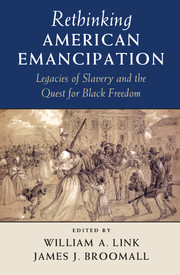Book contents
- Frontmatter
- Contents
- List of figures
- Notes on the Editors and Contributors
- Acknowledgments
- Introduction
- I CLAIMING EMANCIPATION
- 1 Bodies in Motion and the Making of Emancipation
- 2 Force, Freedom, and the Making of Emancipation
- 3 Military Interference in Elections as an Influence on Abolition
- II CONTESTING EMANCIPATION
- III REMEMBERING EMANCIPATION
- Index
1 - Bodies in Motion and the Making of Emancipation
from I - CLAIMING EMANCIPATION
Published online by Cambridge University Press: 05 November 2015
- Frontmatter
- Contents
- List of figures
- Notes on the Editors and Contributors
- Acknowledgments
- Introduction
- I CLAIMING EMANCIPATION
- 1 Bodies in Motion and the Making of Emancipation
- 2 Force, Freedom, and the Making of Emancipation
- 3 Military Interference in Elections as an Influence on Abolition
- II CONTESTING EMANCIPATION
- III REMEMBERING EMANCIPATION
- Index
Summary
Emancipation figures in our imagination as an event of mythic proportions, a sea change splitting American history into two. Yet for enslaved Southerners, emancipation was first and foremost a complex lived experience, a daily reality that took multiple, shifting, and often contradictory forms. Slavery, a system encompassing millions of people, fell apart in thousands of different ways.
Over the last few decades, historians have been able to reconstruct the general contours of the emancipatory process. We now know that the destruction of slavery was slow and uneven, generally following the path of the Union Army's haphazard progress in conquering the South. We know that some slaves leaped at the sight of the first Union soldier, while others exercised extreme caution and stayed on the plantation for months or years after freedom became a fact. We know that certain bondspeople found new opportunities for work, education, and family life soon after ridding themselves of their masters, while others suffered, sickened, and died trying to build new lives.
Perhaps most acutely, we are now aware of the many different ways in which slaves actively took part in bringing about their own liberation. On the plantation, enslaved men and women used the circumstances of wartime to reshape discipline even while their legal status remained the same. They worked less, stole more, pushed back against physical punishment and stood up to masters and mistresses who no longer seemed omnipotent. Slaves whose owners had fled in the face of the enemy burned down the Big House or emptied it of valuables, while others enthusiastically served as informers, spies, and scouts for the Union Army. The destruction of slavery did not happen on a particular day or as a result of a particular act. It materialized across time and space, through countless manifestations of resistance and sabotage, some invisible, some in full view.
Within their arsenal of weapons, flight from bondage was the most potent means for slaves to fundamentally transform their own condition as human chattel while at the same time undermine the slave society as a whole. Emancipation happened first and foremost on Southern roads, where hundreds of thousands of African Americans undertook acts of individual self-liberation through the independent movement of their bounded limbs.
- Type
- Chapter
- Information
- Rethinking American EmancipationLegacies of Slavery and the Quest for Black Freedom, pp. 15 - 41Publisher: Cambridge University PressPrint publication year: 2015

